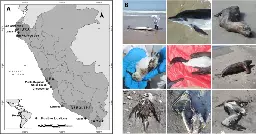Highly pathogenic avian influenza A (H5N1) in marine mammals and seabirds in Peru
Highly pathogenic avian influenza A (H5N1) in marine mammals and seabirds in Peru
Highly pathogenic avian influenza (HPAI) A/H5N1 has recently emerged in the Americas and has been implicated in mass die-off events of pelicans and sea lions. Here, the authors report sampling and characterisation of HPAI A/H5N1 genomes from five marine mammal and seabird species in Peru.

Abstract:
Highly pathogenic avian influenza (HPAI) A/H5N1 viruses (lineage 2.3.4.4b) are rapidly invading the Americas, threatening wildlife, poultry, and potentially evolving into the next global pandemic. In November 2022 HPAI arrived in Peru, triggering massive pelican and sea lion die-offs. We report genomic characterization of HPAI/H5N1 in five species of marine mammals and seabirds (dolphins, sea lions, sanderlings, pelicans and cormorants). Peruvian viruses belong to lineage 2.3.4.4b, but they are 4:4 reassortants where 4 genomic segments (PA, HA, NA and MP) position within the Eurasian lineage that initially entered North America from Eurasia, while the other 4 genomic segments (PB2, PB1, NP and NS) position within the American lineage (clade C) that circulated in North America. These viruses are rapidly accruing mutations, including mutations of concern, that warrant further examination and highlight an urgent need for active local surveillance to manage outbreaks and limit spillover into other species, including humans.